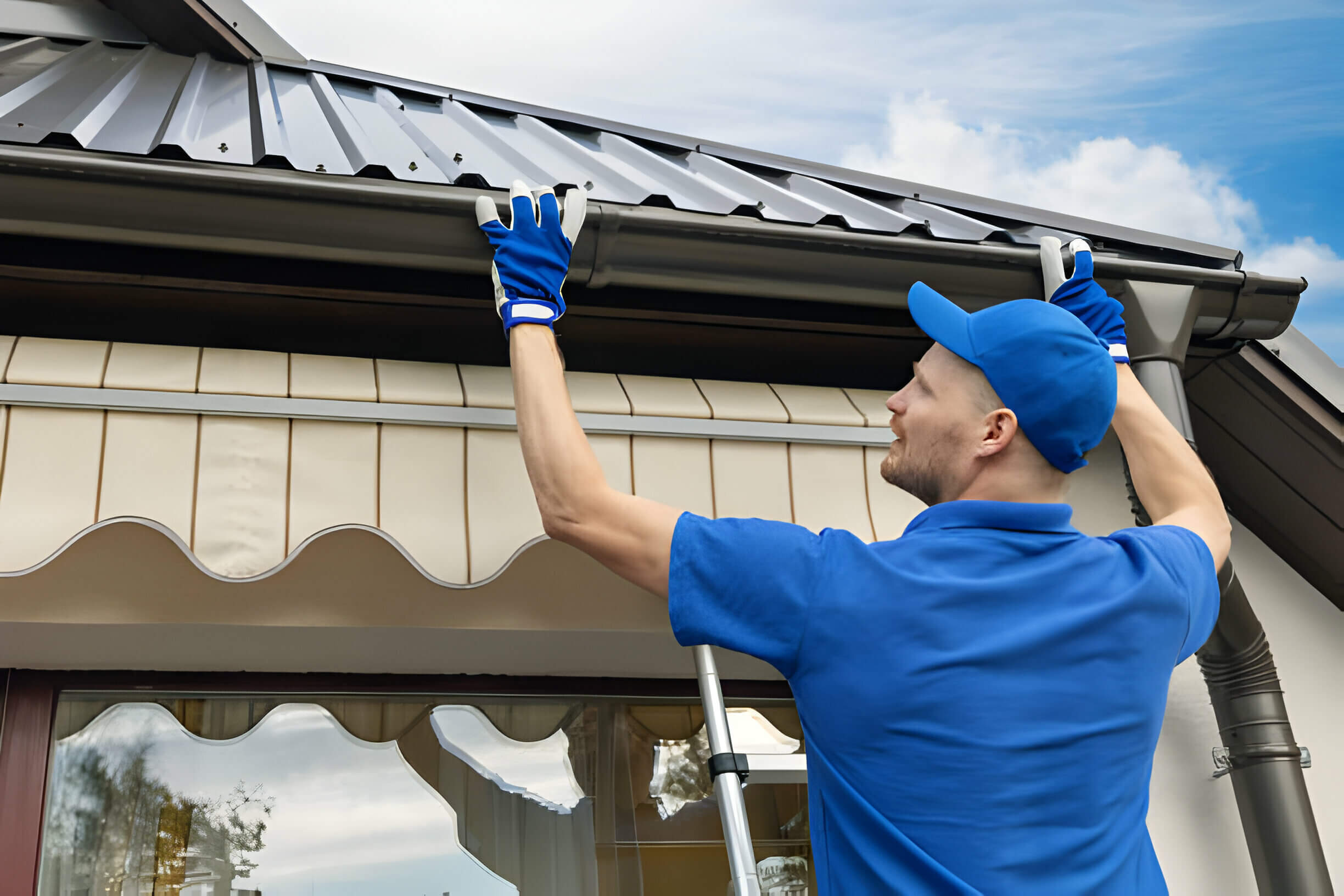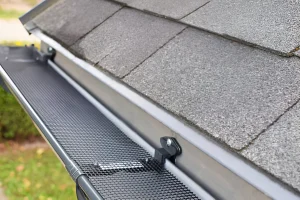Gutters are crucial in safeguarding our homes against water damage by channelling rainwater away from the foundation, walls, and landscaping. Despite their often understated presence, gutters are vital to a home’s structural integrity. Over time, however, wear and tear can diminish their effectiveness, necessitating replacement.
This post will examine eight signs indicating that it may be time to consider replacing your gutters. By proactively identifying these indicators, you can protect your property from potential water-related issues.
8 Signs It’s Time to Replace Your Gutters
Visible Damage to Gutters
One of the most obvious signs that it’s time to replace gutters is the presence of visible damage. This damage can manifest in various forms, including cracks, holes, or rust. Cracks and holes often occur due to age, weather exposure, or physical harm, while rust typically develops over time, particularly in metal gutters. Regardless of the specific type of damage, its impact on gutter functionality can be significant.
Cracks in gutters can develop from stress caused by heavy debris or materials’ natural expansion and contraction due to temperature fluctuations. They may start small but can gradually worsen, leading to leaks and water overflow. Holes can result from corrosion, physical damage, or the presence of sharp objects like tree branches. These openings compromise the gutter’s ability to effectively channel water away from the home, potentially causing water damage to the roof, walls, or foundation.
Rust is a common issue in metal gutters, especially in regions with high humidity or frequent exposure to moisture. Over time, rust weakens the structural integrity of the gutters, making them more prone to leaks and eventual failure.
Visible damage directly impacts the functionality of gutters by compromising their ability to manage rainwater runoff properly. Cracks, holes, and rust allow water to escape from the gutter system, pooling around the house’s foundation or overflowing onto the roof and siding. This excess moisture can result in various issues, including water damage, mould growth, and deterioration of the building materials.
Gutters Are Sagging or Pulling Away from the House
Another telltale sign that it’s time to replace your gutters is when they begin to sag or pull away from the house. This phenomenon is often a result of various factors, including age, inadequate installation, and the accumulation of debris.
Gutters typically sag or pull away due to several underlying reasons:
- Age:Over time, the materials used in gutter construction can weaken, especially if they’re exposed to harsh weather conditions such as heavy rain, snow, and sunlight. This degradation can cause the gutters to lose their structural integrity, leading to sagging.
- Inadequate Installation:Improper installation, such as insufficient fasteners or improper pitch, can also contribute to gutter sagging. When gutters are not securely attached to the fascia board or are installed at the wrong angle, they are more likely to sag or pull away over time.
- Debris Buildup:Accumulated debris like leaves, twigs, and dirt can add weight to the gutters, causing them to sag or pull away from the house. Additionally, debris can trap moisture, accelerating rust and corrosion, further weakening the gutter system.
Sagging gutters compromise their ability to divert rainwater away from the house effectively. When gutters sag or pull away from the structure, they create gaps and uneven surfaces where water can pool or overflow. This can lead to several potential issues.
Excess water pooling around the house’s foundation can seep into the basement or crawl space, causing structural damage and promoting mould growth. Overflowing water from sagging gutters can erode the soil around the foundation, weakening its stability and potentially leading to foundation cracks or settlement. Water overflow from sagging gutters can damage the house’s siding, paint, and trim, resulting in costly repairs and decreased curb appeal.
Water Damage or Marks Beneath the Gutters
It indicates potential gutter failure if you notice water damage or marks beneath your gutters. These visible signs typically manifest as staining, discolouration, or moisture spots on the exterior walls or along the foundation line.
Watermarks or damage beneath the gutters indicate that rainwater is not being properly diverted away from the house. Instead, it may overflow or leak from the gutters, cascade down the walls, and pool near the foundation. This scenario highlights several possible issues with the gutter system.
Accumulated debris, such as leaves, twigs, and dirt, can obstruct water flow within the gutters, leading to overflow and leakage. Clogged gutters cannot effectively channel rainwater away from the house, resulting in water damage to the exterior walls and foundation.
Water may accumulate and stagnate within the gutter system if the gutters are not properly pitched towards the downspouts. This stagnant water can seep through the seams or overflow the edges, causing damage to the fascia, soffit, and siding.
The inefficiency of gutters in diverting rainwater away from the house can have profound implications for the structural integrity and safety of the home. When water is allowed to pool or infiltrate the walls and foundation, it can lead to several adverse consequences, including:
- Foundation Damage:Excess water pooling around the foundation can saturate the soil and pressure the foundation walls, leading to cracks, settlement, or even structural failure over time.
- Mould and Mildew Growth:Moisture infiltration into the walls and crawl spaces creates ideal mould and mildew growth conditions. These fungi compromise indoor air quality and pose health risks to occupants.
- Rot and Decay:Continuous exposure to moisture from leaking gutters can cause wood rot and decay in the structural components of the house, such as the fascia, soffit, and exterior walls. This deterioration weakens the integrity of the building and necessitates costly repairs.
Pools of Water or Erosion Around Your Foundation
The presence of pools of water or signs of erosion around your home’s foundation is a critical indicator of improper water drainage, often linked to malfunctioning gutters. When rainwater is not effectively diverted away from the house, it can accumulate near the foundation, leading to structural issues.
Proper water drainage is essential for maintaining the integrity of a home’s foundation. Several detrimental effects may occur when water can pool or saturate the soil around the foundation. Excessive water accumulation around the foundation can saturate the soil, causing it to expand. This expansion exerts pressure on the foundation walls, leading to cracking, shifting, or settling over time.
In addition to saturation, pooling water can erode the soil around the foundation. As water flows over the ground, it carries away soil particles, creating voids or channels beneath the foundation. This erosion weakens the foundation’s support and stability, increasing the risk of structural damage. Pooled water exerts hydrostatic pressure against the foundation walls, forcing water into cracks and fissures. Over time, this pressure can exacerbate existing cracks or create new ones, compromising the foundation’s structural integrity.
Detecting early signs of erosion around the foundation can help homeowners address drainage issues before they escalate. Here are some tips for spotting these signs:
- Inspect the perimeter of your home regularly for pools of standing water, especially after heavy rainfall or during the spring thaw.
- Look for signs of soil erosion, such as exposed roots, bare patches, or channels forming near the foundation.
- Check for cracks or gaps in the foundation walls, particularly around the base, where water may collect.
- Monitor the condition of your gutters and downspouts for signs of clogging, leakage, or improper drainage.
- Pay attention to any changes in the landscape or grading around your home, as these can affect water runoff and drainage patterns.
Gutters Overflowing During Rainfall
When gutters overflow during rainfall, it signals underlying issues that need attention to prevent further damage to your home. Several factors can contribute to gutter overflow, including blockages and improper installation.
One of the most common reasons for gutter overflow is the accumulation of debris, such as leaves, twigs, and sediment. When debris clogs the gutters or downspouts, it obstructs the water flow, causing it to back up and overflow.
Inadequate gutter installation, such as incorrect pitch or insufficient slope towards the downspouts, can also lead to overflow. If the gutters are not positioned correctly or securely attached to the fascia board, water may not be able to drain efficiently, resulting in overflow during rainfall.
Overflowing gutters can have several adverse effects on your home, from cosmetic damage to structural issues. Excess water overflowing from the gutters can seep into your home’s roof, walls, and foundation, causing water damage and deterioration of building materials. Over time, this moisture intrusion can lead to rot, mould growth, and decay, leading to costly repairs.
Continuous overflow can cause water to spill over the gutters’ edges, damaging the fascia and soffit boards. Water infiltration can cause these wooden components to rot and deteriorate, compromising the structural integrity of the roofline. Overflowing gutters can also saturate the soil around your home’s foundation, leading to landscape erosion. As water accumulates and flows over the ground, it can wash away topsoil, expose roots, and create unsightly trenches, affecting your property’s aesthetic appeal and stability.
If water is allowed to pool around the foundation due to gutter overflow, it can seep into the basement or crawl space, leading to flooding and moisture-related issues. Basement flooding poses severe risks to the structural integrity of the foundation and can cause damage to stored belongings and finished areas.
Paint Peeling on or Around Your Gutters
The paint peeling on or around your gutters is another visible indicator of underlying issues that require attention. Understanding why paint peels on gutters and its significance can help you effectively identify and address potential moisture problems.
Gutters are constantly exposed to the elements, including sunlight, rain, snow, ice, and fluctuating temperatures. Over time, this exposure can cause the paint coating on the gutters to deteriorate, leading to peeling, flaking, or bubbling. Moisture infiltration is a primary cause of paint peeling on gutters. When gutters become clogged or damaged, water can accumulate and seep beneath the paint surface, causing it to lose adhesion and peel away.
In metal gutters, the presence of rust can contribute to paint peeling. Rust forms when the protective coating on the gutter surface is compromised, allowing moisture to come into contact with the metal substrate. As rust develops, it expands and lifts the paint layer, leading to peeling and corrosion of the gutter material.
Paint peeling on or around gutters is often a visible manifestation of moisture problems within the gutter system or surrounding areas. The relationship between peeling paint and moisture issues is significant for several reasons. Peeling paint is a warning sign of potential water damage to the gutters, fascia, soffit, and adjacent building materials. Moisture infiltration beneath the paint surface can lead to rot, decay, and structural deterioration.
Peeling paint may indicate the presence of hidden leaks or cracks in the gutter system that allow water to penetrate the substrate. These leaks can go unnoticed for an extended period, causing progressive damage to the underlying structure and increasing the risk of mould growth and wood rot. Peeling paint diminishes the protective barrier of the gutters, leaving them vulnerable to further deterioration and corrosion. Without proper maintenance and repair, the structural integrity of the gutters may be compromised, leading to premature failure and the need for replacement.
Gutters Require Frequent Repairs
When gutters require frequent repairs, it can become a source of frustration and financial strain for homeowners. Over time, constantly addressing leaks, sagging, or damage can result in significant costs and effort. The cost and effort of frequent repairs versus replacement are essential in determining the most economical and practical course of action.
The cost of frequent repairs can add up quickly, especially if multiple issues arise with the gutter system. Repair expenses may include materials, labour, and hiring professionals to address complex problems. Over time, these costs can exceed the initial investment in gutter replacement. Continuously repairing gutters requires time and effort from the homeowner or hired professionals. Each repair task, whether patching leaks, reattaching sagging sections, or replacing damaged components, consumes valuable time and resources.
Repairs may provide temporary solutions to underlying issues in some cases, leading to recurrent problems and the need for further maintenance. This cycle of repair and reparation can become tiresome and ultimately ineffective in addressing the root cause of gutter problems.
When It’s More Economical to Opt for Replacement:
- Extensive Damage:Replacement may be the most cost-effective option if the gutters have sustained extensive damage or deterioration beyond repair. Continuing to repair severely damaged gutters may only prolong the inevitable need for replacement, resulting in higher overall costs.
- Aging Gutters:Older gutter systems nearing the end of their lifespan may require frequent repairs due to wear and deterioration. Investing in new gutters can provide long-term benefits in terms of durability, efficiency, and reduced maintenance needs.
- Cost-Effectiveness:In many cases, opting for gutter replacement can be more cost-effective in the long run compared to ongoing repairs. While replacement incurs an upfront expense, it eliminates the need for continual maintenance and repair costs over time.
- Enhanced Functionality: New gutter systems offer improved functionality, efficiency, and performance compared to older, outdated models. Upgrading to modern gutter technology, such as seamless gutters or gutter guards, can provide superior water management and reduce the likelihood of future issues.
Your Gutters Are Over 20 Years Old
If your gutters are over 20 years old, they may have surpassed their expected lifespan. Understanding the average lifespan of various gutter materials and recognizing signs that age has impacted gutter performance can help determine whether replacement is necessary.
- Aluminum:Aluminum gutters are popular due to their lightweight, corrosion-resistant properties. On average, aluminum gutters can last between 20 to 30 years with proper maintenance and care.
- Vinyl:Vinyl gutters are affordable and easy to install but have a shorter lifespan than other materials. Typically, vinyl gutters last between 10 to 20 years, although their durability may vary depending on climate conditions and exposure to sunlight.
- Steel:Steel gutters are durable and robust, making them suitable for areas prone to harsh weather conditions. Galvanized steel gutters have an average lifespan of 20 to 50 years, while stainless steel gutters can last 50 years or more with proper maintenance.
- Copper:Copper gutters are known for their aesthetic appeal and longevity. With proper care, copper gutters can last 50 to 100 years or more, making them a durable and long-lasting option.
As gutters age, they may develop rust or corrosion, particularly in metal gutters such as steel or aluminum. Rust spots, corrosion, or visible deterioration along the gutter surface indicate that age has impacted the structural integrity of the gutters.
Over time, gutters may begin to sag or pull away from the fascia board due to the weakening of the attachment points or structural components. Sagging gutters can compromise proper water drainage and may indicate age-related deterioration.
Age-related wear and tear can cause gutters to develop cracks, holes, or seam separations, leading to water leaks and overflow issues. If you notice water dripping or pooling around the gutters during rainfall, it may be a sign that age has impacted the gutter’s performance.
Peeling paint, discolouration, or visible signs of deterioration on the gutter surface indicate that age has affected the protective coating or finish. Peeling paint may expose the underlying material to moisture damage and accelerate aging.
Conclusion
In conclusion, timely gutter replacement is crucial for maintaining the integrity and functionality of your home’s water management system. Over time, gutters can deteriorate due to age, weather exposure, and wear and tear, leading to leaks, overflow, and water damage. By promptly replacing old or damaged gutters, you can prevent costly repairs, protect your property from water-related damage, and ensure the longevity of your home’s exterior.
So, inspect their gutters regularly for signs of wear, damage, or inefficiency. Conducting routine maintenance and promptly addressing issues can help prolong your gutters’ lifespan and prevent potential problems. If you’re unsure about the condition of your gutters or need professional assistance, consider consulting with a professional gutter service provider like EavesArmour.
Say goodbye to the hassle of eavestrough cleaning and ice dam formation with EavesArmour Gutter Guard. Our all-season protection system ensures clog-free gutters for life, with a discreet and low-profile design that works on all roof and gutter systems. And with our lifetime transferable warranty, you can rest easy knowing your home is protected. Don’t wait any longer to upgrade your gutter system. Experience the peace of mind that comes with EavesArmour today.
EavesArmour also offers professional gutter cleaning to save you time and money and help prolong the life of your home’s gutters. With over ten years of professional experience, EavesArmour is your partner for gutter maintenance. Call today at 647-931-0441 or fill out our convenient online formto learn more about our services and how we can safeguard your home against gutter-related issues. Trust EavesArmour for professional gutter guard installation and all your gutter needs and enjoy peace of mind knowing that your home is well-protected.






